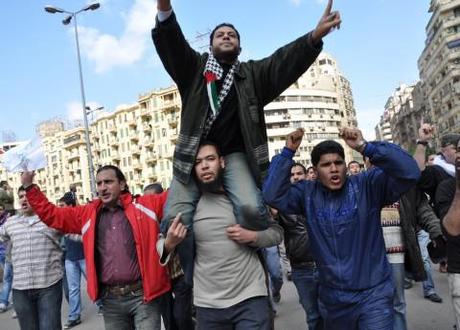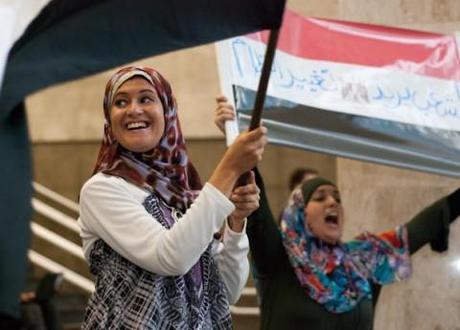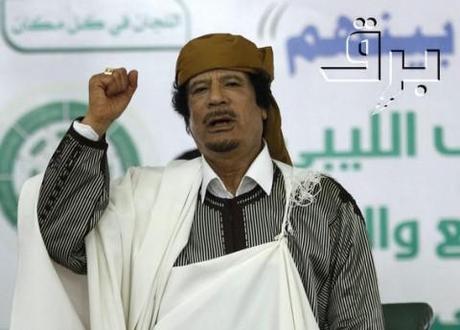
Anti-Mubarak protesters in Tahrir Square, Cairo, Jan. 30, 2011. Photo credit: Floris Van Cauwelaert
You probably don’t need us (or Time magazine, for that matter) to tell you that 2011 was the year of the protest and the protester. From Tahrir Square, Cairo, to Zucotti Park, New York, protests, sometimes violent, rocked the established order and entrenched elites to the very core. Radical populist movements have achieved momentum and attention and will continue to change the way we life our lives and how we are governed into 2012, perhaps beyond.
The Arab Spring uprisings, which erupted in Tunisia in January, saw members of the aging Arab autocrat club including Hosni Mubarak (Egypt), Zine El Abadine Ben Ali (Tunisia) and Colonel Muammar Gaddafi (Libya) toppled after decades of dictatorial rule. The Occupy Movement began on Wall Street as a protest against fat-cat bankers, but quickly mushroomed into a global movement with camps in London and across America. In Greece, citizens rioted against austerity measures; in London, citizens rioted out of rage at police and privilege; and on-line, Anonymous and its merry band of hacktivists simply ran riot.
And the spirit of global protest shows little sign of abating at the year draws to a close. Russian pro-democracy and anti-corruption protests have some wondering if Prime Minister and presidential hopeful Vladimir Putin may finally be losing his iron grip on power. Could the so-called “Russian Winter” bring an abrupt end to Putinism just as Middle East’s jasmine revolutions unseated Mubarak and Ben Ali?
“It’s fair to say that 2011 has been something of a global cluster-fuddle. If you’re a murderous Arab dictator, a Greek civil servant or a London student, it’s been a total mare,” observed Richard Goodwin of The London Evening Standard.
Of course, the year’s multiple protests vary in their causes and aims. But, as Time magazine’s Kurt Anderson noted, “[I]t’s remarkable how much the protest vanguards share. Everywhere they are disproportionately young, middle class and educated. Almost all the protests this year began as independent affairs, without much encouragement from or endorsement by existing political parties or opposition bigwigs. All over the world, the protesters of 2011 share a belief that their countries political systems and economies have grown dysfunctional and corrupt.”
With that in mind, here’s The Periscope Post’s round-up of the protest movements which flared and flamed the brightest in 2011.
Tunisia: The Arab Spring blossoms. The self-immolation of street vendor Mohamed Bouazizi in Sidi Bouzid, protesting police corruption and ill treatment, is widely considered as the event which sparked the Tunisian revolution and Arab Spring. Following a month of increasingly bold street demonstrations, longtime President Ben Ali left office on on 14 January 2011. The Tunisian demonstrations were fueled by high youth unemployment, food inflation, corruption, lack of freedom of speech and other forms of political freedom, and poor living conditions. These, or similar, frustrations were also what brought people out on to the streets across the Arab world in 2011.
The largest, most organised Arab Spring demonstrations often occurred on a “day of rage”, usually Friday after noon prayers. Social media sites such as Facebook have proved to be protesters’ key organizing tool.

Egyptians celebrating the country's democratic turn. Photo credit: Marcel Maia
Egypt’s jasmine revolution. Hot on the heels of Tunisia’s revolution, street protests began in Egypt on 25 January and ran for 18 days. Despite President Mubarak government’s efforts to shut down the internet to eliminate the nation’s internet access, protests mounted, and, on 11 February, he was forced to resign as president. A massive 4.5 million Egyptians protested during those three weeks and the toppling of Mubarak was celebrated wildly in Cairo’s Tahrir Square. But initial jubilation was replaced by frustration with the Supreme Council of the Armed Forces’ perceived sluggishness in instituting meaningful reforms. Protesters reoccupied to Tahrir Square in November and clashed with security forces in December, amid the three-week-long Parliamentary elections. Egypt’s revolution is, in many ways, still unfinished.
With all this protest it was inevitable that some pretty awesome protest placards and signs hit the streets in 2011. Worldwide web surfers have flocked to sites such as Buzzfeed to rate the power (and sometimes humour) of the protest messages. The Periscope team selected the seven punchiest placards – check them out here.

Libyan leader Muammar Gaddafi. Photo credit: B.R.Q.
Libyan civil war. Anti-government protests began in Libya on 15 February 2011. By 18 February, the Libyan opposition controlled most of Benghazi, the country’s second-largest city. But Colonel Muammar Gaddafi’s grim determination to fight to the bloody end meant there was to be no quick, relatively bloodless revolution in Libya. Gaddafi loyalists brutally repressed protests and Libya descended into civil war. On 17 March, United Nations Security Council Resolution 1973 was adopted, authorising a no-fly zone over Libya. Two days later, France, the United States and the United Kingdom intervened in Libya with a bombing campaign against pro-Gaddafi forces. The intervention did not lead to the immediate end of Desert Fox Gaddafi, however – it wasn’t until August that rebel forces captured Libyan capital Tripoli. Gaddafi went on the run and was finally tracked down and killed in Sirte on 20 October.
The Tunisan and Egyptian revolutions and Libya’s civil war were the headline-grabbing events in the Arab Spring uprisings but there were certainly not the only significant protests in the Middle East and North Africa in 2011. There were civil uprisings in Bahrain, Syria, and Yemen; major protests in Algeria, Iraq, Jordan, Kuwait, Morocco, and Oman; and minor protests in Lebanon, Mauritania, Saudi Arabia, Sudan, and Western Sahara.
Greece in flames. Anti-austerity protesters took to the streets of Athens and other major Greek cities through much of 2011 to oppose government plans to cut public spending and raise taxes as austerity measures in exchange for a €110 billion bail-out, aimed at solving the Greek debt crisis. The demonstrations, which were largely inspired by Spain’s anti-unemployment, anti-corruption Indignados (The Outraged) movement, drew larger crowds and turned increasingly violent as the country’s economic climate worsened through the year. On 29 June, particularly violent clashes occurred between protesters and riot police as the Greek parliament voted to accept the EU’s austerity requirements.
The BBC Newsnight’s Economic Editor Paul Mason, author of upcoming book Why It’s Kicking Off Everywhere: The New Global Revolutions, told London’s Evening Standard, ”The greatest source of hope for me is to see a generation rising who think all forms of hierarchical ideological activity are rubbish. Even the most rapacious people in the world finance system get that an uncaring form of capitalism is unsustainable. You’d have to celebrate that moment because there have not been many moments like it.”
Occupy Wall Street, Occupy London Stock Exchange … Occupy, err, Everywhere. Partly inspired by the Arab Spring protests (an early Adbusters call-to-arms email stated “America needs it own Tahrir”), the Occupy Movement, which is chiefly directed against corporate influence on democracy and seeks to force politicians to address a growing disparity in wealth in the West, began on 17 September in New York City. And, boy, did it snowball. By 10 December, organisers were reporting 2,720 Occupy communities worldwide. The Occupy movement took a lot of stick in the media for a perceived lack of unified aims but its participatory democracy-style organisational methods, and determination to fight corruption, captured the public’s imagination from Kuala Lumpur to Zurich. Occupy received support from writers, filmmakers and musicians, which helped maintain it momentum.
On November 10, 2011, The Daily Telegraph reported that the word “occupy” had been the “most commonly used English word on the internet and in print” over the past 12 months, according to a top ten list published by media analysis company Global Language Monitor.
We are Anonymous. While the most potent images of the year in revolution were of placard-holding protesters and rioting citizens, much of the most powerful anti-Establishment protest this year has actually taken place online. Self-styled “hactivist” collectives such as Anonymous and LulzSec have performed some audacious denial of service raids and more sophisticated hack attacks in defence of online freedom, in support of causes they sympathise with, such as the Tunisian revolution or WikiLeaker Bradley Manning, and, sometimes, just for the sheer lulz of causing mayhem.
Bad times in Belarus: A silent protest on the streets of Minsk was brutally suppressed by police over the summer. The country’s authoritarian president Alexander Lukashenko threatened to “strike hard” against those who opposed his regime, reported the BBC – and did.
August England riots. What started as a peaceful protest in North London over the police shooting of 29-year-old Tottenham man Mark Duggan ended in buildings ablaze and violence on the streets of the London neighbourhood. Over the next few days, rioting spread across London and then to other English cities. Looters targeted stores in Manchester, Birmingham, Liverpool and Nottingham, and there were violent clashes with police. In the aftermath, courts worked overtime to hand out sentences to rioters, described variously as too harsh and too lenient. Social networking sites and tools such as Twitter and BlackBerry Messenger came under scrutiny amid allegations they had been used to incite violence. But the real debate focused on the causes of the riots, and is still rumbling on: In November, the government published a report claiming the August rioters were motivated by greed and boredom, but a Guardian/LSE study from December insisted the underlying causes were resentment of the police and social injustice.
Veteran protestor Brian Haw died of lung cancer in June at the age of 62. Haw had been a thorn in the UK government’s side for over ten years after he set up camp outside Parliament to protest against the Iraq war.
UK on the march. Billed as Britain’s largest walk-out since the General Strike in 1926, the public sector pensions protest in November didn’t actually cripple the country as expected. In fact, Prime Minister David Cameron described the action as a “damp squib”. Many commentators sympathised with protestors’ aims – apart from, inevitably, The Daily Mail – but some also suggested that the strikers were unlikely to win over public sympathy given the general economic climate of doom and gloom. But at least the November strike was largely trouble-free: Violence flared at a union-sponsored anti-cuts protest in March, with 201 arrested after The Ritz was attacked and protestors occupied Central London store Fortnum & Mason.
Travellers were evicted from Dale Farm after a ten-year legal battle with Essex’s Basildon Council, with riot police entering the camp during the early hours of the morning. Some activists claimed the eviction amounted to “ethnic cleansing”.
Unstoppable cascade of protest not seen since 1848. Still not sold on the idea that 2011 was a year like no other? Here’s Kurt Anderson’s take on 2011, a year “unlike any year since 1989 – but more extraordinary, more global, more democratic, since in ’89 the regime disintegrations were all the result of a single disintegration at headquarters, one big switch pulled in Moscow that cut off the power throughout the system. So 2011 was unlike any year since 1968 – but more consequential because more protesters have more skin in the game … It was … unlike anything in any of our lifetimes, probably unlike any year since 1848, when one street protest in Paris blossomed into a three-day revolution that turned a monarchy into a republican democracy and then … inspired and unstoppable cascade of protest and insurrection in Munich, Berlin, Vienna, Milan, Venice and dozens of other places across Europe.”
More on the Arab Spring
- Arab Spring: Moderate Islamist An-Nahda party claim victory in Tunisia’s first democratic election
- Gaddafi is dead – who’s next?
- Asma al-Assad’s greatest hits
- Violence erupts in Cairo

